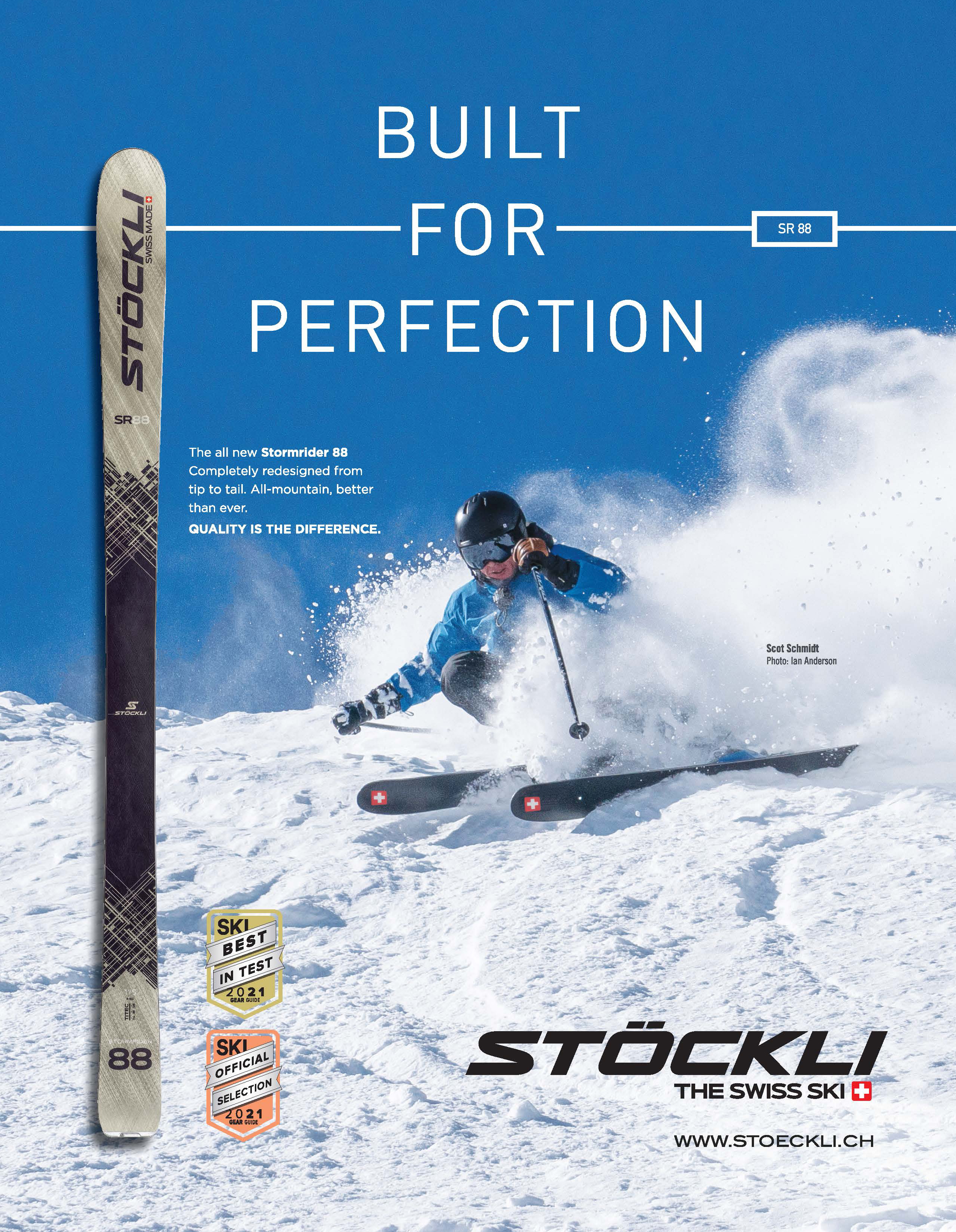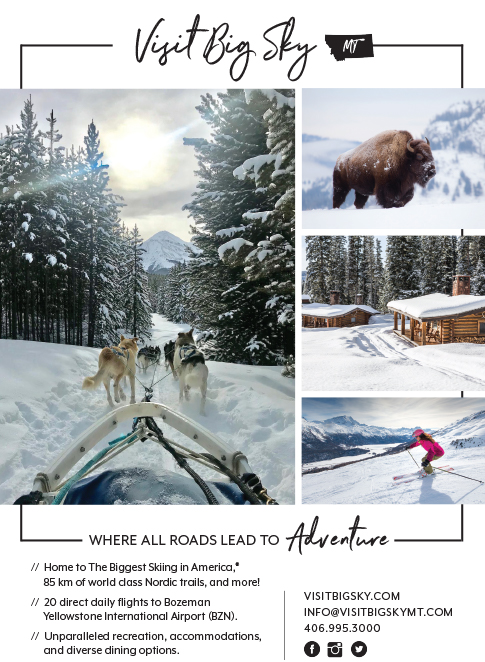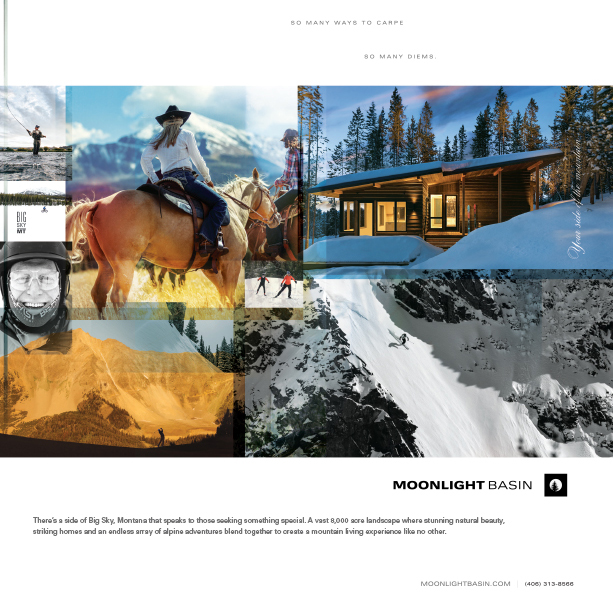Coming of Age
Warren Miller Entertainment legends meet the next generation of rising stars to shred big lines in Montana.
Photos by Ian Anderson
Scot Schmidt, Tom Day, and the Egan Brothers (aka John and Dan) are skiers who require little introduction. Pioneers of extreme skiing turned lifelong ski bums, they owe much of their success to Warren Miller, the man who made them stars of the ski world by showcasing their talent on the silver screen. Each appeared in numerous Warren Miller films between 1983 and 2013 before taking a hiatus to pursue their individual professional ski careers.
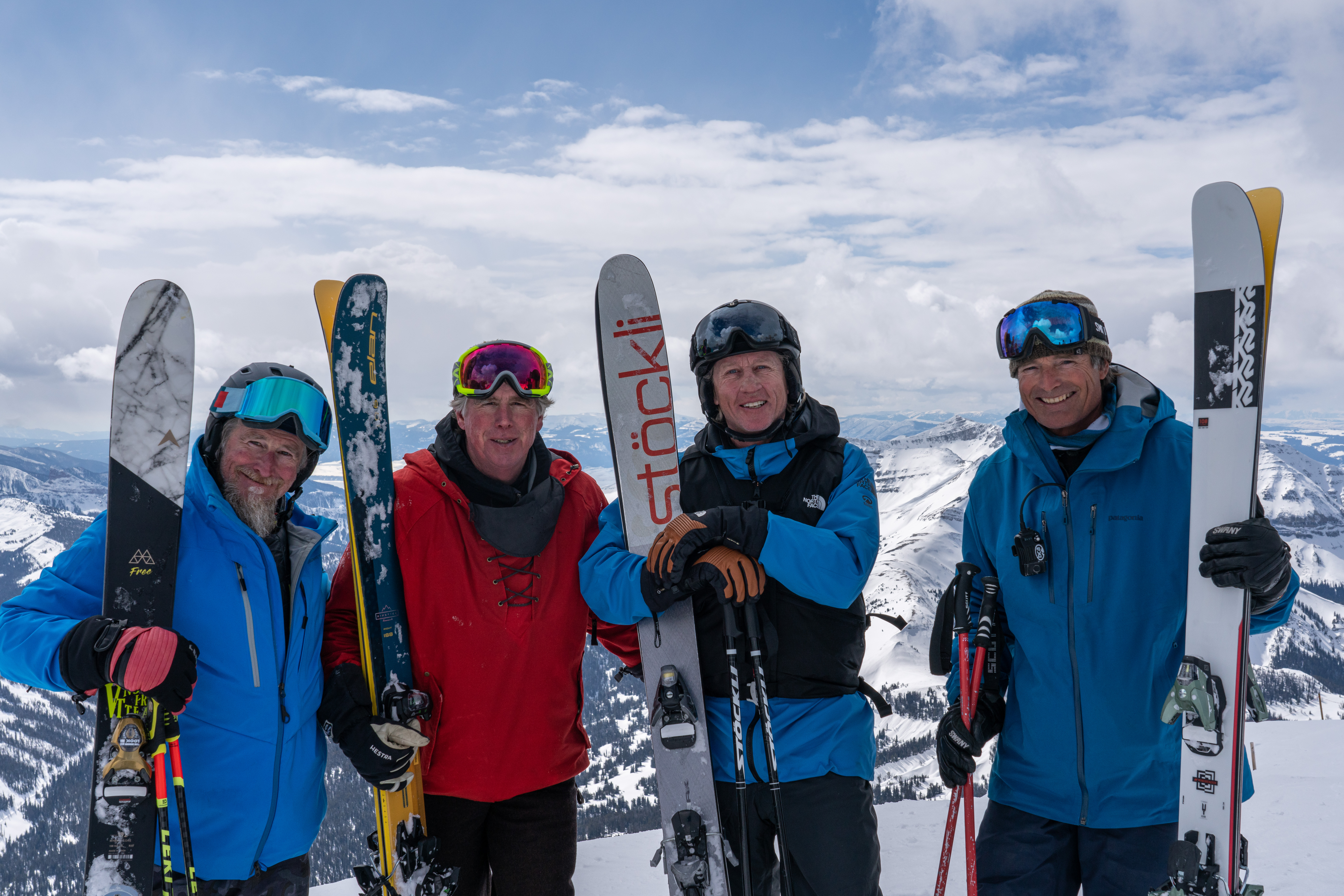
Left to right: John Egan, Dan Egan, Scot Schmidt and Tom Day
In March 2020, the four Legends reunited in Big Sky, Montana, to show the new kids on the block a thing or two about tackling big lines and skiing with style. Those new kids? Twenty-something freeride phenoms, Parkin Costain and siblings Maria and Jack Lovely. More than four decades and countless ski gear evolutions separate the old pros from the rookies, but one thing becomes clear—their dedication to living a life that revolves around skiing transcends that generational gap. Here Dan Egan, Maria Lovely, Schmidt, and Costain offer a look back at the “good old days” of ski bumming, as well as predictions for where skiing is headed in the future.
Q: Using your own words, define “ski bum.”
M. Lovely: Ski bum is a very broad term. I would say it’s someone who loves skiing so much that they go out of their way to do it as much as possible.
Schmidt: It’s a title well-deserved, it’s not derogatory. It’s a dedication. It’s a way of life. If people want to call it being a ‘bum’ then that’s fine with me. It’s an awesome way of life that I wouldn’t change for anything. That’s the short answer.
Costain: Someone who dedicates all their time and money to the sport, who works all summer and does everything they can to play all winter. It’s putting everything you have into your passion, and you wouldn’t take anything in the whole world over it.
D. Egan: It’s following your passion to make a living. There are ski bums that live to ski. They’ll load lifts or drive cabs. But we were professional ski bums. We had a career in mind to project over a lifetime. The mentor for that was Warren Miller. If you look at John [Egan], Tom [Day], and Scot, we were all successful in achieving that. That came from Warren. Warren gave us advise on things like how to invest money.
Q: Name one time you really “bummed it” for the sake of skiing. Any true dirtbag experiences?
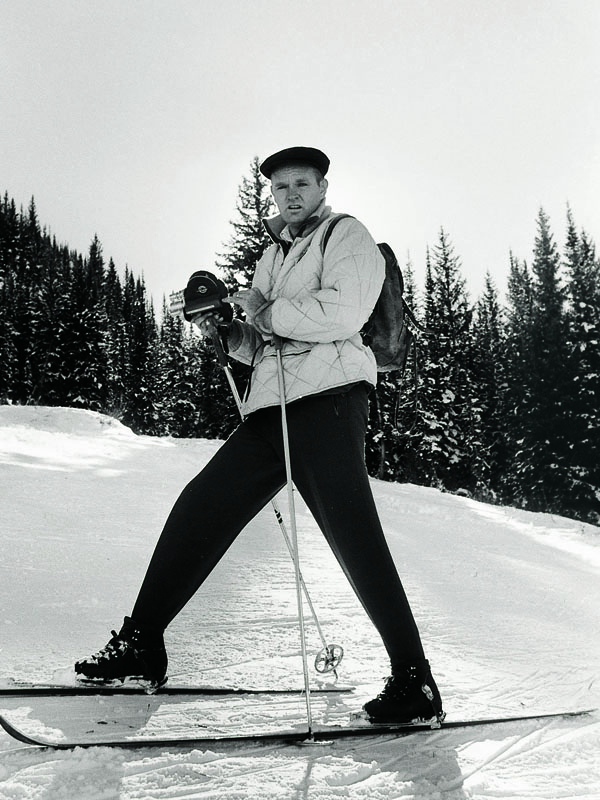
Warren Miller began making ski films in 1949 while living in a teardrop trailer in the Sun Valley parking lot.
Schmidt: Everyone has this impression of a ski bum like Warren Miller, eating oyster crackers with ketchup and sleeping in your car. I did that. When I moved to Squaw in ’79 I got dropped off in the parking lot with all my racing gear. I didn’t know anybody. I had to stash my gear in the woods and sleep in an abandoned building for a few days until I found a job and found my way. I spent a lot of nights in the parking lot, a lot of cold nights, too. Everybody has to go through something until they find their niche.
M. Lovely: On one ski trip I was in Canada. We were working for a resort, but only for a certain number of days, so the last two days of the trip we didn’t have a hotel room. We had all these groceries that we bought, mostly canned soup, but we had nowhere to heat them up so we just ate cold soup right out of the can.
D. Egan: [John Egan and I] worked every angle. When we first went to Big Sky, we knew Warren was going there to shoot Scot and Tom Jungst, so we went a week early and told them we were the Warren Miller crew and they put us up and fed us for a week. We were on our way to Fernie and needed a place to stay. That’s ski bumming. Then Warren told us we couldn’t hand out his business cards anymore.
Q: How has the idea of the ski bum evolved in recent decades?
Schmidt: Resort towns have changed. You can’t camp out in the parking lots anymore—very few ski areas allow it. That lifestyle has kind of gone. Resort towns are now boom towns. There are a lot of opportunities there, whether you’re a builder or instructor. So, people don’t really have to bum it anymore … but as long as skiing is your day job, and you just have a job on the side to support that, then you’re still a ski bum.
M. Lovely: There are more options now. People are starting to think outside of the box a little bit more about how they can accomplish a ski bum life. In the back of my mind I’ve always thought of the ski bum as the liftie who’s going to bump chairs all winter long. But now there are a lot of different ways to make it happen. You see a lot of VanLife and people traveling, people who stay at the resort and work there for 20 years, or people who switch resorts every winter. It’s just becoming more of a thing that you can make your own.
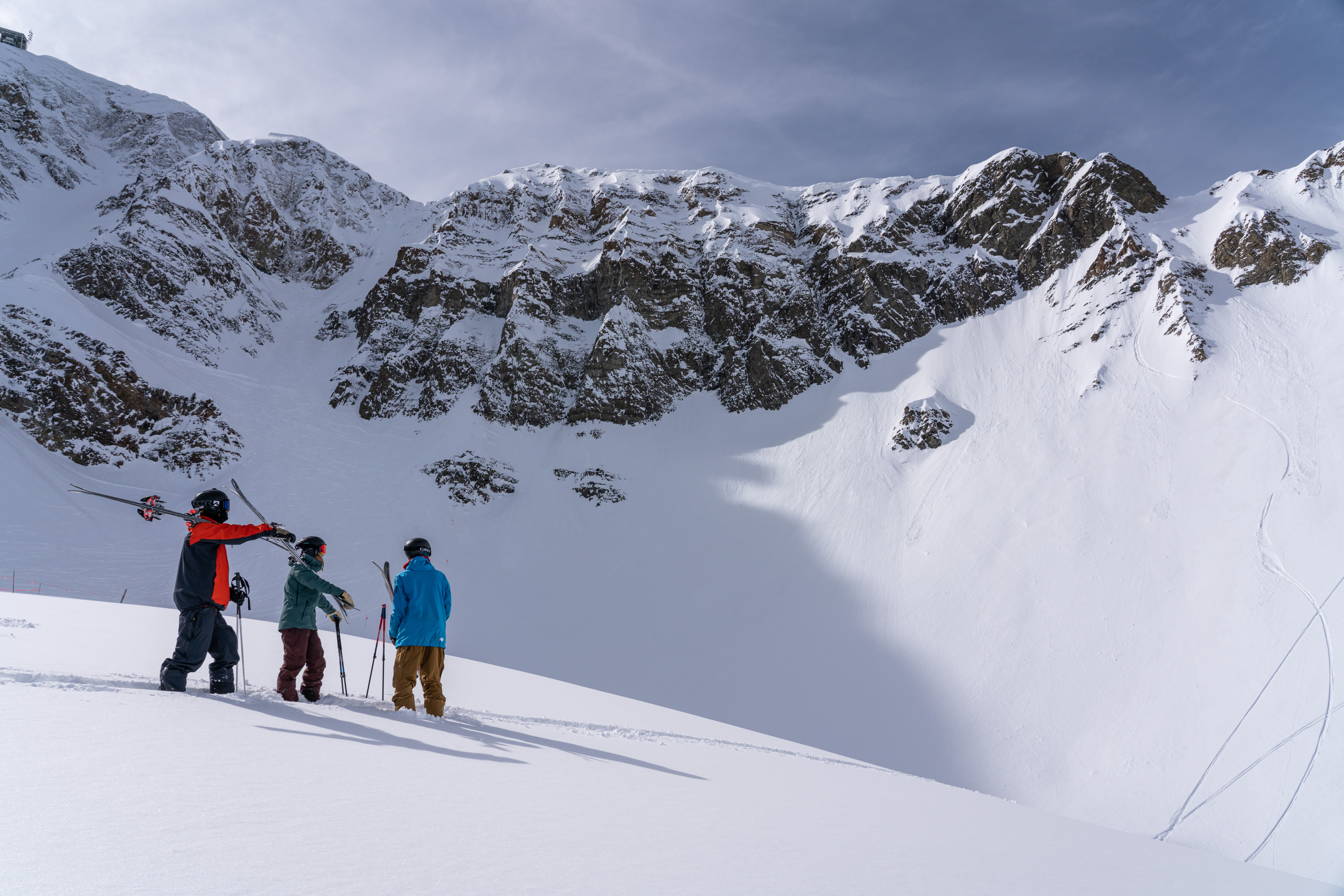
Parkin Costain, Maria Loveley and Jack Loveley all grew up in Montana.
Q: When you think of “retro” skiing style, what comes to mind?
Schmidt: I think back to what I thought was cool when I was really young, and that was the Jean Claude Killy era in the ’60s and the old Spider Sabich stuff. Then I got into racing, and it was Ingemar Stenmark. Those guys were my heroes. I developed my style and technique by studying Ingemar Stenmark’s. Killy, with those boots and skis, there was no technique—it was survival skiing. But Ingemar started really carving and getting angulated, and I really liked that style. That’s why I have a lot of angulation and independent leg action—I always tried to look like Ingemar. I studied his books, his sequences, his World Cup techniques in the early 70s, and it just stuck.
M. Lovely: When I think of retro, I think of the style of skiing that the Legends [Scot, Dan, John, and Tom Day] exhibit. It goes back to the days of long, skinny skis. It’s a very different style—it’s very beautiful and well put together, and fun to watch. In this film, you’ll see the four Legends coming down the Big Couloir, where Jack [Lovely] and I were standing at the top watching them weave their way down, in that total retro style of skiing together—shorter turns, standing up a little bit taller, skis a little bit closer together, and pretty synchronized. Just a very fun, lighthearted style.
D. Egan:Retro or ‘back in the day’ is different to each generation. I always say extreme skiing came out of hot dogging. Our roots are in showmanship. There’s an argument to be made that extreme skiing wasn’t a sport, it was entertainment. Because of the VHS tape, it became something we could sell. We weren’t alpinists, we were showmen. To that end, Wayne Wong and those guys were my retro—they skied in stretch pants, in sweaters. They ripped moguls and did crazy airs. That was our roots as East Coasters. We were racers and bump skiers. My retro is also Ingemar and Maher brothers. And of course, you can’t say all of that without mentioning Stein Erikson. When you look at that group of skiers, there was a level of excellence and of creativity.
Throwback With The Egan Brothers from Warren Miller Entertainment on Vimeo.
Q: Has skiing changed much over the last couple decades?
Schmidt: Not that much has changed. Clothes are definitely better, they’ve gotten warmer. Boots haven’t changed in forever, I wish they would evolve someday. But the skis—oh my god, it’s so much easier to ski these days. Anybody can do it now, and it didn’t use to be that way. It’s made my job so much easier. I’m actually enjoying skiing again, because I don’t take a beating. It’s so much more enjoyable. Shorter and lighter works.
Costain: The level of skiing has gone up exponentially, because the equipment has gotten to be that much easier to use. People are skiing five-times faster than they used to. Maybe we’re not jumping cliffs more than they used to, but we’re now stomping them on our feet thanks to the new equipment.
D. Egan: The skiing tribe is deeper and richer than ever before. And I think we’re going to see that more alive than ever before thanks to COVD-19. I think we’re going to see more people hanging out in parking lots, booting up and eating sandwiches, not going to eat in lodges. You’re going to see that tribe come alive. I look at that core skier group that keeps expanding—the Parkins and the Lovelys—and watch that world open up to them. When we were coming of age, the group was narrow. Now, thanks to the accessibility of the sport and social media, it’s broad and opening. Back in the day, we were wearing dayglow outfits and jumping off cliffs—we were freaks. But now resorts are doing their part to welcome that part of the sport. They’re building parks and jumps—they’ve grown and expanded with that movement.
Q: When would you say the heyday of skiing was? Or, is it yet to come?
Schmidt: Every day is the heyday of skiing. I’ve had so many great experiences, and they just keep getting better and more fun.
M. Lovely: I think that there was a big heyday back in the ’70s when everyone was really pushing it, trying new things and new tricks that had never been done before. I also think that this next generation, the kids that are now 12 or 13, are doing things that Jack [Lovely] and I weren’t doing when we were that young. Kai Jones is a great example of someone who is pushing it, and I think wow—there’s still so much to come.
Costain: You can always look back, and hindsight is always 20/20. I think today is a really exciting time. And I’m curious to see how it goes in the future. I can’t imagine that equipment is going to progress that much more, I think we’ll just continue to become more confident in what we’re doing. Every day I look at Instagram, someone is doing a new trick or going even bigger. So I’m trying to figure out what I’m going to do next season to up my game.
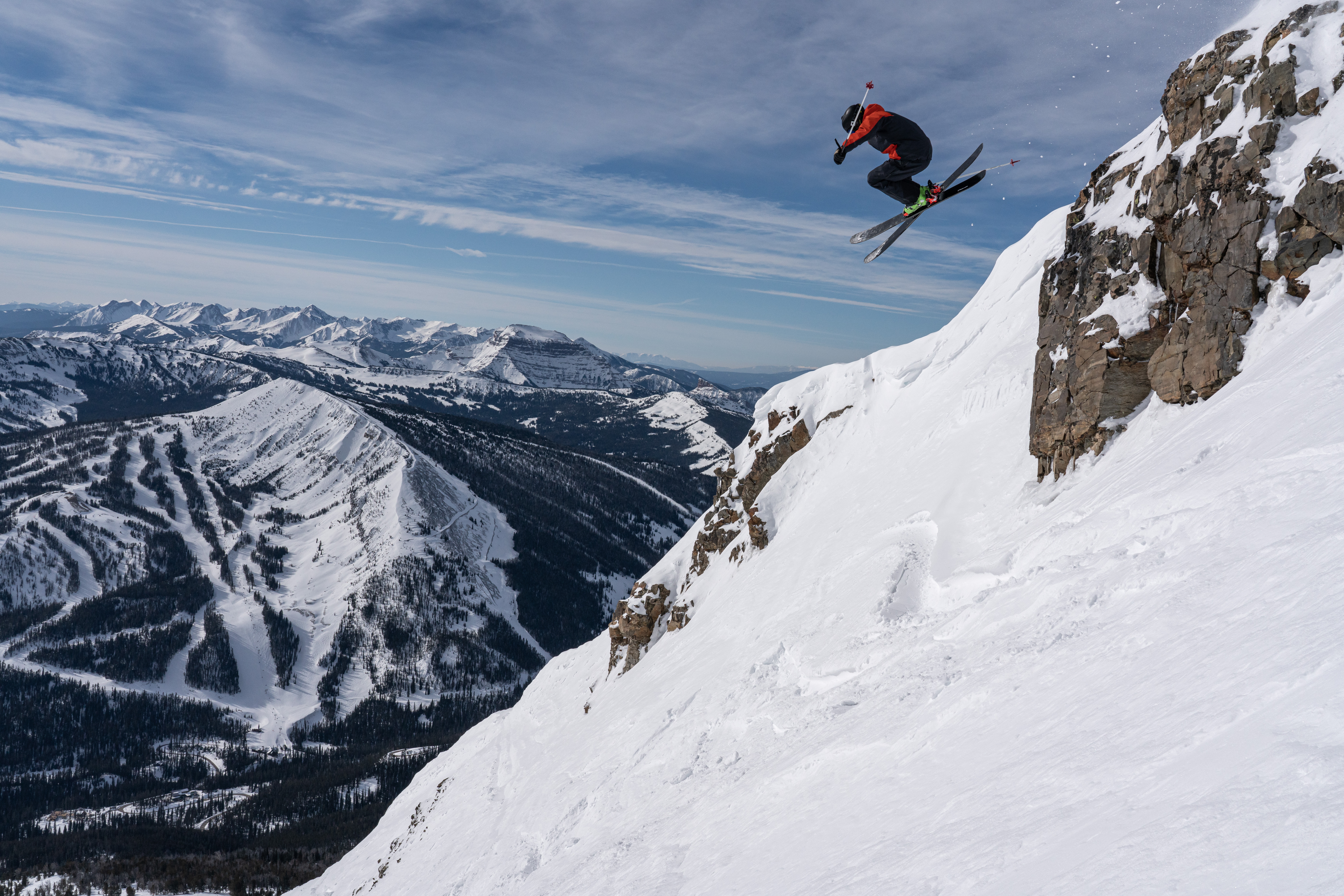
Parkin Costain catches air in Montana.
D. Egan: Everybody’s always recreating their heyday. They are flipping and twisting and grabbing and base jumping. So, the heyday goes back to your perspective of time. I think each generation can claim a heyday. There’s an argument to be made that the boom of condos and snowmaking was a big growth period for skiing. But we’re far from stagnant. I’m proud of being part of my generational heyday. And of course, we all want to think our generation was the best. But in the end, when you see generations hanging out together, what you see is that skiing is timeless. Skiing on, over, and through powder is contagious and timeless.
Q: Is there anything you miss about skiing “back in the day?”
M. Lovely: The lack of rules. I wish I could ski when there were fewer rules, and back before social media when there was less ego and fewer people telling you how skiing should be. I feel like back then, everyone just went out and it was solely about having a good time. Not about the social rules—what you wear, how your skiing is perceived, how tight your goggles and helmet fit. I feel like back then, there was less of that. But it’s hard for me to say since I wasn’t there.
D. Egan: Two-person lifts. What’s been lost over the years because we want to be more efficient is the transformation that happens on a double chairlift with a stranger or a family member. That’s an experience that everyone should have. Sitting side by side, speaking or not, it’s a shared experience. That’s one thing that has been lost. And maybe this year quads will become doubles, and that experience will be regained. That transformation for me is the soul experience of skiing.
Q: What’s your favorite memory of Warren Miller—either the man or his films?
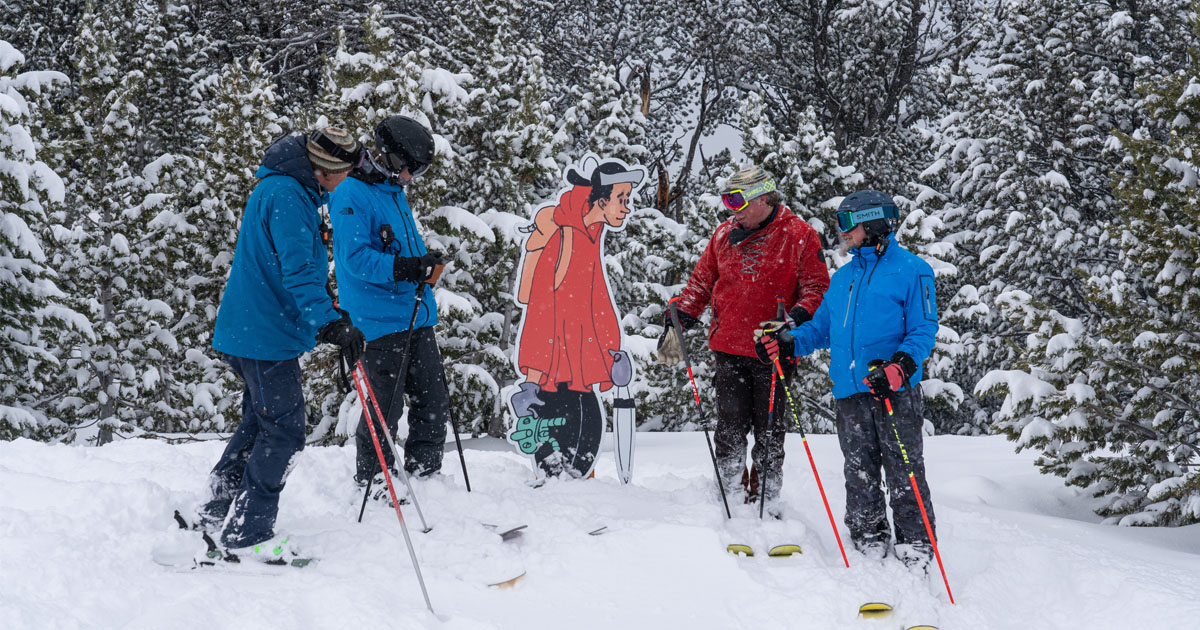
Tom Day, Scot Schmidt and the Egan Brothers pay a visit to the Warren Miller Ski Bum, based on the Warren's sketch from back in the day.
D. Egan: My favorite Warren memory was when we would go to Hermosa beach, and he would practice his narration. His theater had the names of every movie on the back of the seats. Sitting there, working on the narrations with Warren, that was an experience I’ll never forget. I loved that Warren took the time to teach me that.
Schmidt: My favorite memory of Warren would be going to 505 Pier Avenue for a private screening of “Ski Time” with Warren Miller, the man. That was my first screening, the first time meeting Warren—the giant—in person, as he narrated the rough cut live. Seeing myself on the silver screen was a highlight. I didn’t really get to know him until later in life, until everything came full circle in Montana. After he sold [Warren Miller Entertainment], we went our separate ways. It wasn’t until I was at the Yellowstone Club that I rekindled that relationship with Warren again. He was always hosting or entertaining groups. You could ski by his house and anytime the flag was out you could stop in to have tea.
M. Lovely: Every time I picture Warren Miller, I see him in my head with this huge smile on his face. He brought so much joy out of the sport and people. He was able to capture that joy that we all get from skiing an put it on film and share it with the world. I feel like I definitely missed out on meeting Warren Miller, but I’m so grateful to be able to work with people like Scot Schmidt who he passed the torch onto because I think his spirit lives on in them. And I feel like I could say that about us future generations too—even though we didn’t get the chance to meet Warren, his spirit and joy for skiing is being passed on through us.
Explore: Big Sky Resort, Montana
Not for nothing does this Montana resort attract big names Scot Schmidt and Parkin Costain and convert them to locals. There’s a lot that makes Big Sky special—like, a whole lot.
- Average Annual Snowfall: 400+”
- Skiable Acres: 5,850 (No. 3 in North America)
- Lifts: 38 (including the Ramcharger 8, the first eight-seat, bubble lift in North America)
- Vertical Drop: 4,350 feet
- Summit Elevation: 11,166 feet
Making of "Future Retro" | Montana from Warren Miller Entertainment on Vimeo.
---
This content was created in partnership with SKI Magazine.


